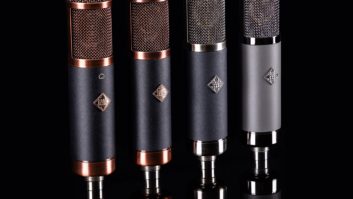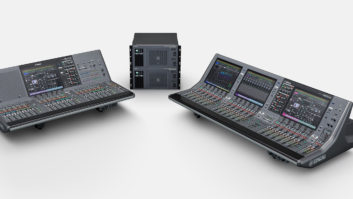New Orleans, LA (November 22, 2019)—A lot has changed since front-of-house engineer Travis Bing began mixing Kacey Musgraves. Just 18 months ago, she was opening for established acts like Little Big Town and Harry Styles, playing on their stages and largely to their crowds.
But what a difference those experiences have made—not to mention the four Grammys won by the third Kacey Musgraves collection, Golden Hour, including Album of the Year. Over the course of the Oh, What a World Tour, which began in October 2018, she packed arenas, indoor theaters and everything in between with an enthusiastic fan base all her own.
The year-long run played everywhere, from two nights at the recently opened 2,200-capacity Fillmore in New Orleans—the smallest room of the tour—to Nashville’s Bridgestone Arena, where Musgraves broke the female attendance record of any genre at the venue, with 18,373 fans in attendance.
“When I first started, my mix in an arena all the way at front of house was running around 91–92 dB—nice and chill,” said Bing. “Now everyone’s singing every word to every song all night long, they’re cheering, they’re hitting 110, 112 dB out front. It’s very different from where we started a year and a half ago.”

Regardless of a venue’s size, some things stay the same when it comes to mixing, said Bing: “It’s [about] trying to keep your reflections to a minimum when you can, and then understanding how much the room will change with people in it. My process is not freaking out during soundcheck when it seems a little chaotic, ’cause everything tends to tighten up, especially indoors, once people are here and there’s an open floor.”
Bing landed the gig after running boards for pop-punk powerhouse Paramore, which called for a significantly different focus. While Paramore’s instrumentation is loud and guitar-driven, Musgraves’ show was built carefully around her vocals, with a dozen instruments moving in and out of the mix underneath.
“It’s not that she wants the typical country vocal, way-out-front mix,” he said. “She wants it to be a very full, nice, even blend of everything, but she does want those moments of vocals and big background vocals. Blending it all together has been a challenge. [I’ve been] really working on my vocal game with her.”
Bing’s experience with dynamic vocalists like Hayley Williams of Paramore and Chris Carrabba of Dashboard Confessional has given him a substantial knowledge of microphones. When he arrived on the Kacey Musgraves team, he worked with the artist to find the most appropriate mic to capture her vocals, rotating through a variety of handhelds before ultimately settling on a wired Telefunken M81 and Shure’s flagship Axient Digital wireless outfitted with a M81 capsule, providing options as needed. “Hayley [Williams] used the
M80 and I thought that was going to be the right mic for Kacey, but turns out it’s the M81. Honestly, you think, what is such a subtle difference on their specs with the frequency response, and it’s a massive difference on her. We’ve tried to go back to using an M80 in emergency situations, and everything changes. My gain structure changes, EQs have to change.” Opting for the M81 capsule has made all the difference, he said, noting, “It stays the same no matter if she’s right on it or way off of it. The tone’s even.”
Clair Global provided control and monitor gear for the production, and the FOH position was centered around a DiGiCo SD10 console, with a Waves SoundGrid Extreme Server nearby running a variety of Waves 10 bundles like Mercury, Studio Classics and Abbey Road. Adjacent racks featured familiar units like a Lake LM44 system processor and a Rupert Neve Designs Portico II Master Buss Processor. Bing ran 65 inputs comprised almost entirely of live instruments, including steel guitar, cello, keys, upright and traditional electric bass, often being played at the same time. His job wasn’t just about following the instrument changes; it was about finding spots in the mix for everything.
“I think the one saving grace I have is they’re a really solid band that wants to work together to make sure levels are staying even, tones are right and nothing’s on top of anything else,” he said. “They’re really good about policing themselves on where to fit in the mix, which makes it so much easier.”
The tour used local line arrays through its run, so at New Orleans’ Fillmore, for instance, Bing was mixing to a system based around JBL VTX V Series hangs. Unusually, all subs were flown above the stage and behind the lighting rig, minimizing the impact of performances on the front rows. “Sometimes when you just have flown subs, you don’t feel it as much up front, which is kind of the opposite of the feeling everyone’s used to,” he said, “but it’s carrying to the back of the room, and it feels really nice.”

At stageside, Dalton VanVolkenburgh ran monitors through another DiGiCo SD10 console with in-ear monitors for all seven performers and individual mixes. He kept a stable of outboard processors for vocals, and was particularly attached to using a Rupert Neve Designs 5045 Primary Source Enhancer for Musgraves’ personal mix.
“It allows me to isolate her vocal a little bit,” he said. “She has a delicate voice and doesn’t have to push very hard to get those qualities out. I usually have to run a little bit more gain into her mic, so the bleed from all of that can be a problem. With that 5045, I can run it really hot, isolate the vocal and keep the rest of the instruments out of the mix.”
Using a switcher, VanVolkenburgh was able to give Musgraves the latitude to experiment with microphones night to night and during the set. “Sometimes she’ll be on a wireless upstage and then she’ll walk downstage to a wired vocal, and both of those need to hit that 5045,” he said.
Even a year into mixing the well-choreographed and rehearsed show, Bing and VanVolkenburgh agreed they have to stay on top of their game mixing the live band. “Each night’s a little bit different,” Bing noted. “They might be playing different. Their energy level could be up or down. You never know what you’re going to get, and I think that’s awesome. I want different nuances and to stay fresh.”
Clair Global • www.clairglobal.com
DiGiCo • www.digico.biz






